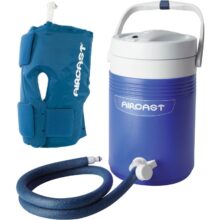Hot & Cold Therapy
Hot and cold therapies, also known as thermotherapy and cryotherapy, respectively, have long been utilized as effective modalities in the field of healthcare.
These therapeutic techniques involve the application of heat or cold to the body to promote healing, reduce pain, and manage various medical conditions.
In this article, we explore the wide-ranging applications of hot and cold therapy in healthcare and their significant benefits for patients.
Understanding Hot and Cold Therapy
Hot therapy involves the application of heat to targeted areas of the body, while cold therapy involves the use of cold or ice. Both approaches work by altering blood flow and temperature, influencing physiological responses within the body.
Applications of Hot Therapy
Pain Relief
Hot therapy is widely used to alleviate pain associated with muscle strains, joint stiffness, and chronic conditions such as arthritis. The application of heat helps relax muscles, increase blood flow, and improve tissue flexibility, thereby reducing pain and promoting relaxation.
Muscle Relaxation and Spasm Reduction
Muscle spasms and tension can be effectively managed through hot therapy. The heat applied to the affected area helps relax muscle fibers, reduce muscle spasms, and enhance mobility. This is particularly beneficial for individuals with back pain, neck pain, or sports-related muscle injuries.
Rehabilitation and Injury Recovery
Hot therapy plays a crucial role in rehabilitation and injury recovery. It promotes blood flow, which aids in the delivery of oxygen and nutrients to injured tissues, facilitating the healing process. Heat also helps reduce joint stiffness, improve range of motion, and accelerate tissue repair following sprains, strains, or surgeries.
Stress Reduction and Relaxation
Hot therapy, such as warm baths or hot packs, offers psychological benefits by promoting relaxation and stress reduction. The soothing warmth can help relieve tension, ease anxiety, and promote overall well-being. It is often used in conjunction with other relaxation techniques, such as massage or aromatherapy.
Applications of Cold Therapy
Pain Management and Inflammation Reduction
Cold therapy is highly effective in managing acute pain, reducing inflammation, and minimizing swelling. Applying cold or ice to injured or inflamed areas constricts blood vessels, decreases tissue metabolism, and numbs nerve endings, providing pain relief. It is commonly used for sprains, strains, post-surgical recovery, and acute injuries.
Sports Injuries and Rehabilitation:
Cold therapy is frequently employed in the immediate treatment of sports injuries. The application of cold compresses or ice packs helps reduce swelling, control bleeding, and minimize tissue damage. Cold therapy is often used during the early stages of rehabilitation to decrease pain and inflammation, facilitating the healing process.
Headaches and Migraines
Cold therapy can provide relief from headaches and migraines. Applying a cold pack or ice wrap to the forehead or the back of the neck helps constrict blood vessels, reduce pain, and alleviate tension. It offers a non-pharmacological approach to managing headaches and can be particularly beneficial for individuals who prefer drug-free solutions or experience medication side effects.
Dental and Oral Health
Cold therapy is utilized in dental and oral healthcare to alleviate pain and inflammation. Cold packs or ice packs are applied externally to the face or jaw area following oral surgeries, tooth extractions, or dental procedures to reduce swelling and discomfort. The numbing effect of cold therapy provides temporary pain relief and promotes healing.
Conclusion
Hot and cold therapies are versatile and effective modalities with a wide range of applications in healthcare. Whether it is providing pain relief, reducing inflammation, promoting relaxation, or aiding in injury recovery, hot and cold therapy offer non-invasive and drug-free treatment options. Healthcare professionals leverage the therapeutic benefits of hot and cold therapy to improve patient outcomes, enhance rehabilitation, and optimize overall patient well-being.








